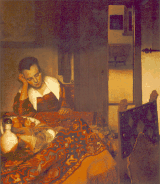A Girl Asleep
New York, Metropolitan Museum
87x76 1657
 (Large)
(Large)
Here, for the first time, we see the light, mood, complex composition, and the
symbolism characteristic of mature Vermeer. The girl is well-dressed,
perhaps the lady of the house, and we are separated from her by a table
and chair. There is a white pitcher, similar to that in
The Glass of Wine and The Music Lesson;
and in front of the girl is an almost invisible wine-glass:
presumably she is sleeping off the wine.
When the painting was sold in 1696, it was entitled
Een dronke slafende Meyd aen een Tafel, [A drunken sleeping maid
at a table], then in 1737 it was sold again, but as Een slapent Vrouwtje
[A sleeping young woman]. The painting is similar to the Nicholas Maes'
The Lazy Maid, except that in the latter, the maid
looks like she is really asleep, whereas the Vermeer maid seems to be
only cat-napping.
The table is covered in a rich oriental carpet, with a bowl of fruit,
symbolic of the Fall of Eve, and a partially wrapped egg, implying
unbridled lust. Broken eggs on the floor are a common symbol in the
work of another 17th century Dutch artist, Jan Steen. Above the girl is
a dimly lit picture with a masked face visible-- it is thought to
depict deception and sincerity in love. X-rays reveal that
a man framed in the doorway has been painted over.
There is a strong contrast between the rumpled look of the foreground and
the spare ordiliness of the back room, implying that the lady of the house
is not doing her duties. Presumably her disappointment in her extra-marital
affair made her hit the sauce and ignore her wifely duties.
Brought to you by
BallAndClaw.com.
 (Large)
(Large)